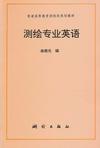测绘专业英语
出版时间:1996-10 出版社:测绘 作者:曲建光 编 页数:282 字数:242000
前言
本教材供专科学校工测专业学生使用,也可作为本科测绘专业学生及有关工程技术人员学习专业英语的参考书。 本书课文选自于近年来英美两国出版的测绘著作和文献,所选文章包括了专科工测专业各有关专业课的基本内容和一些当前测绘学科发展的新内容。 本教材每篇课文后都有词汇表、注释、语法与翻译技巧和练习。生词以大纲规定的二级水平为基础,并侧重于专业意义。注释主要是长句和语法复杂的难句及一些词的特殊用法的说明。习题采用了三种形式,主要是检查学生对课文的内容、结构、关键词及翻译技巧的理解程度。语法和翻译技巧部分结合语法介绍了翻译的基本技巧和一些具体句子的译法,同时为了突出专业特点,例句主要选自原版测绘著作和文献。另外,为了帮助学生掌握好词汇,每两篇文章后附有一篇word study,主要介绍近义词或同义词之间的区别和用法。书后附有总词汇表。 由于编者水平有限,书中难免有错误和不妥之处,恳请批评指正。
内容概要
《测绘专业英语》课文选自欧美等国出版的测绘著作和文献,所选文章包括专科工测各有关专业的基本内容。每篇课文后都有词汇表、注释、语法与翻译技巧和练习,书后附有总词汇表。《测绘专业英语》供专科学校工测专业学生使用,也可作为本科测绘专业学生及有关工程技术人员学习专业英语的参考书。
书籍目录
Lesson One Introduction to SurveyingLesson Two Bubble TubesLesson Three Surveying InstrumentsLesson Four Theodolites (1)Lesson Five Theodolites (2)Lesson Six LevelsLesson Seven Level Rods and LevelsLesson Eight Electronic Distance MeasurementsLesson Nine Errors in Electronic Distance MeasurementsLesson Ten Errors in MeasurementsLesson Eleven Surveying Field Notes(l)Lesson Twelve Surveying Field Notes (2)Lesson Thirteen Leveling (1)Lesson Fourteen Leveling(2)Lesson Fifteen Profile LevelingLesson Sixteen Adjustments of Level CircuitsLesson Seventeen Sources of Error in LevelingLesson Eighteen TraversingLesson Nineteen Topographic SurveyingLesson Twenty TriangulationLesson Twenty-one Staking Out (1)Lesson Twenty-two Staking Out (2)Lesson Twenty-three PhotogrammetryLesson Twenty-four Survey AdjustmentLesson Twenty-rival The Global Positioning SystemAppendix I Geo-Information SystemsAppendix II Vocabulary
章节摘录
Aerial Surveying An engineer may have air-photographsof a site on which he has to design or set out works. It is impor-tant that he should understand their uses and limitations.Though an air-photograph will probably show all the detailsthe engineer requires, and indeed probably very much more, itmust not be treated as a map because it is not possible to ensurethat the axis of an air-camera is exactly vertical. The tilt may beseveral degrees in a so-called vertical photograph, so there maybe appreciable differences of scale between opposite sides of aphotograph. In any case, even if the camera axis is vertical, therelative positionS of points at different heights will not be cor-rectly shown.The most valuable property of an air-photograph is that an-gles round a point at or close to its center may be regarded ascorrect, and in making maps from air-photographs this propertyis exploited. In other words, a near-vertical air-photograph maybe regarded as a record of angles taken at its center point or anypoint very close to the center.
图书封面
评论、评分、阅读与下载
用户评论 (总计4条)
- 朴实无华,经典
- 在当当网买教材才是最放心的,书是教材当然没得说。
- 每单元主题清晰明了。生单词量也较适当。主要是还有长句、疑难句的解析和翻译,还有数量不算多的课后练习。用这本书当教材很不错!
- 适合用作参考书
相关图书
- 大比例尺数字测图
- 环境制图
- 变形监测分析与预报
- 大地测量学论文专集
- 地图信息识别与提取技术
- 中国测绘史.第1卷(先秦-元代)、第2卷(明代-民国)
- 日语常用副词用例
- 中国测绘史(第3卷)
- 土地信息系统理论与方法
- 多分辨率空间数据模型理论与实现技术研究
- 数学规划在测绘学中应用
- 地图学的研究与实践
- 中国历史地图集(第五册):隋、唐、五代十国时期
- 中国历史地图集:第四册:东晋十六国·南北朝时期
- 中国地形图
- 中华人民共和国地图
- 中国气候资源地图集
- 中国抗日战争史地图集
- 中国历史地图集 第二册
- 中国历史地图集 第三册
- 中国历史地图集(第七册):元、明时期
- 中国自然地理图集
- 莫斯科旅游图
- 小学社会图册第一册
- 社会图册(第3册)
